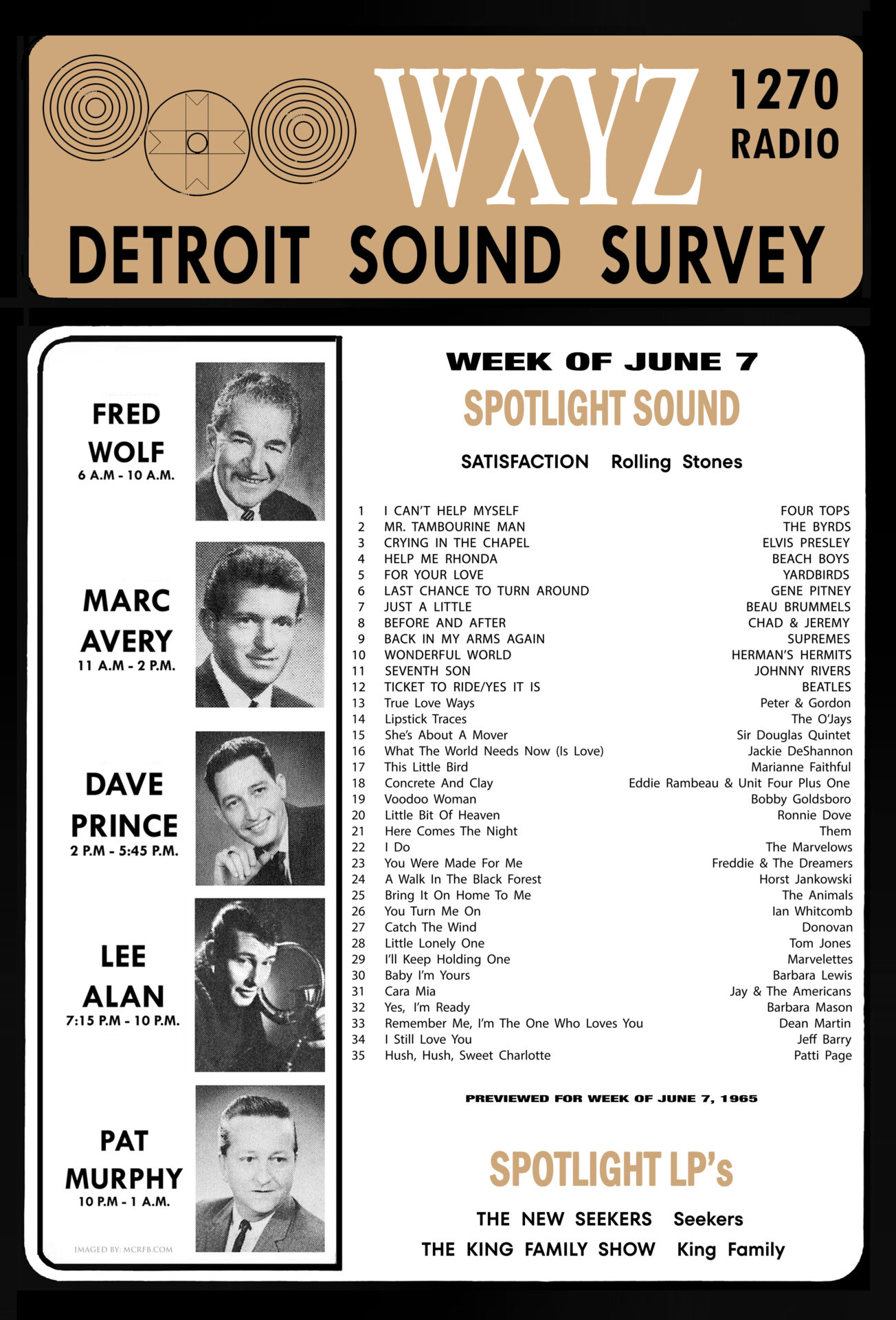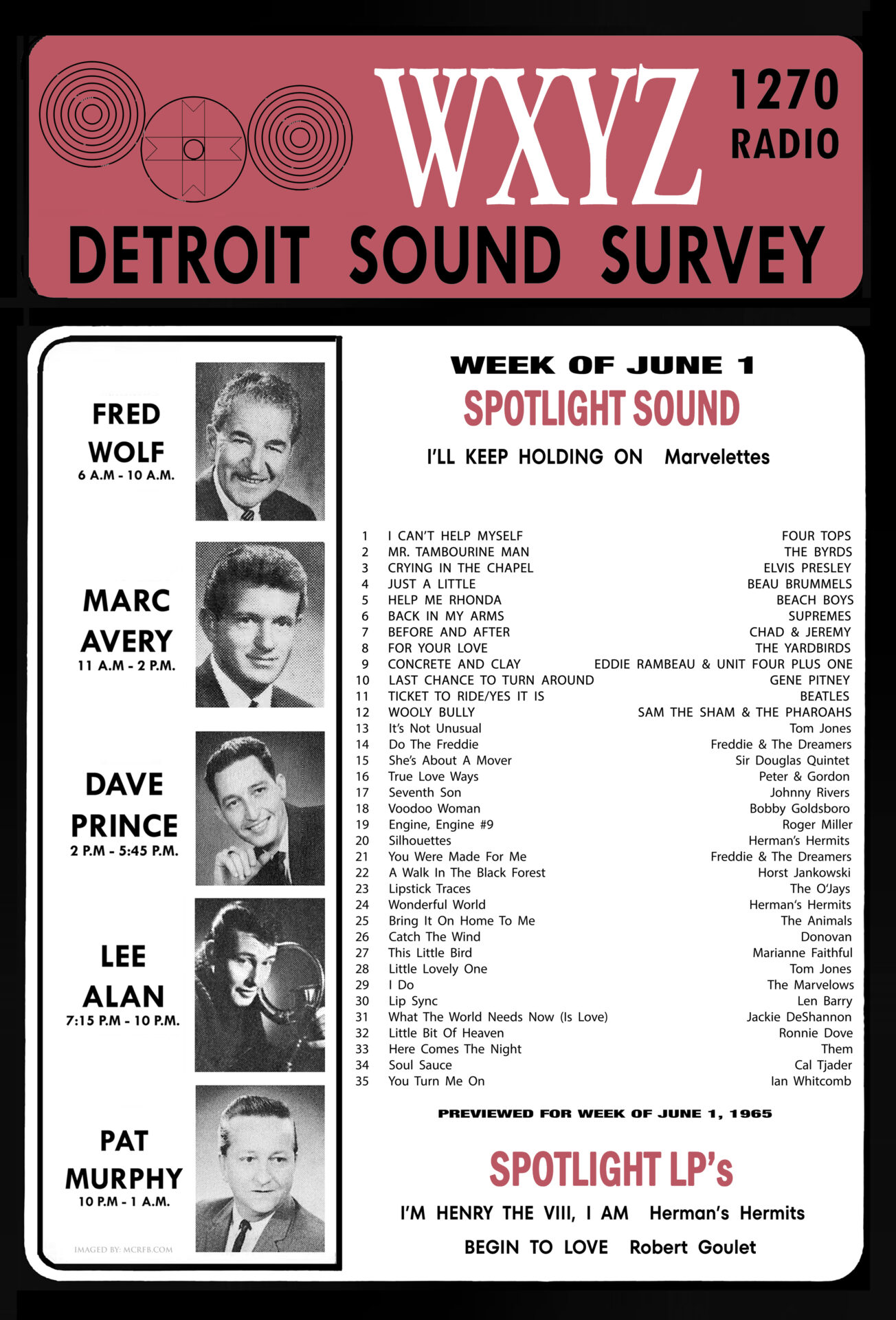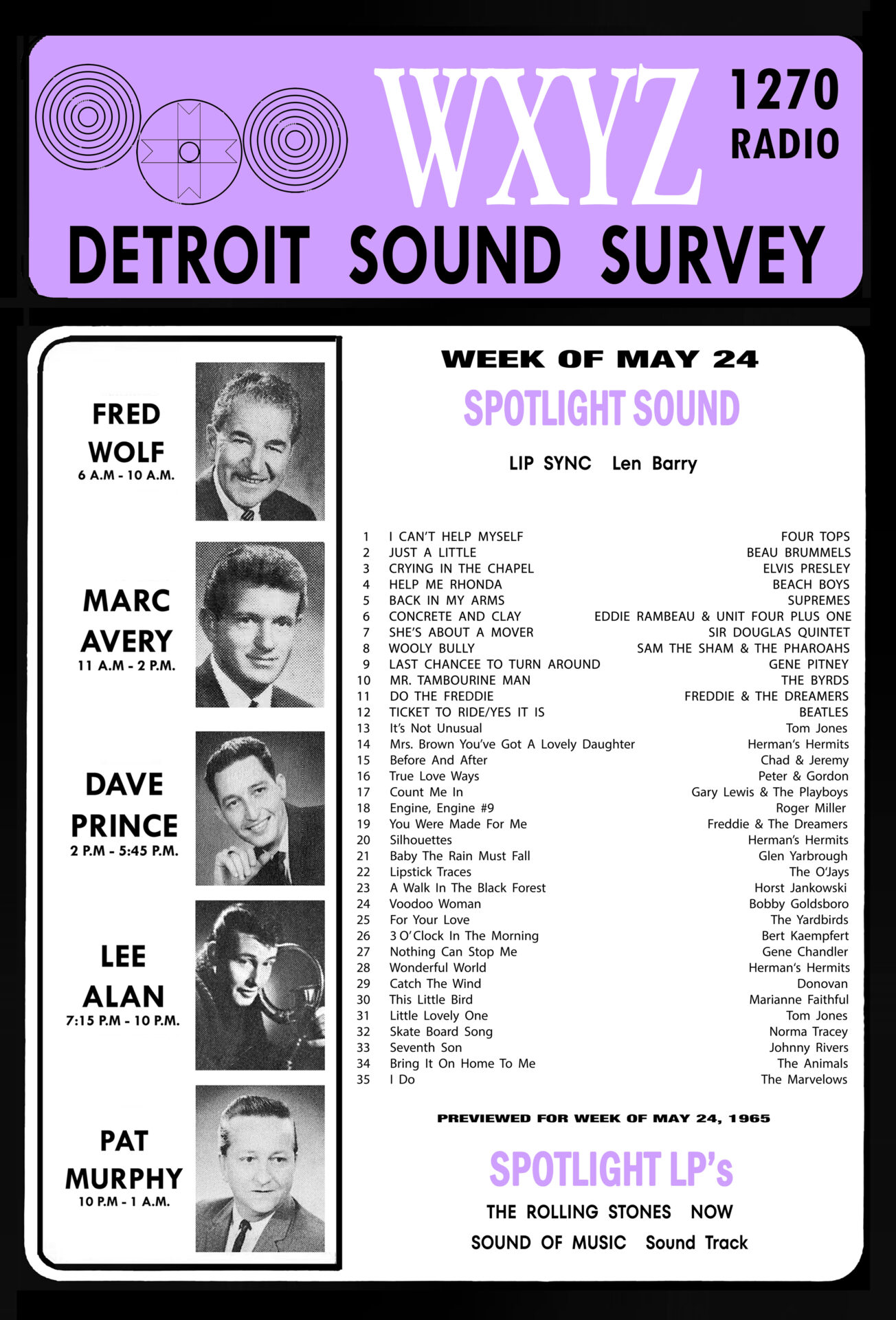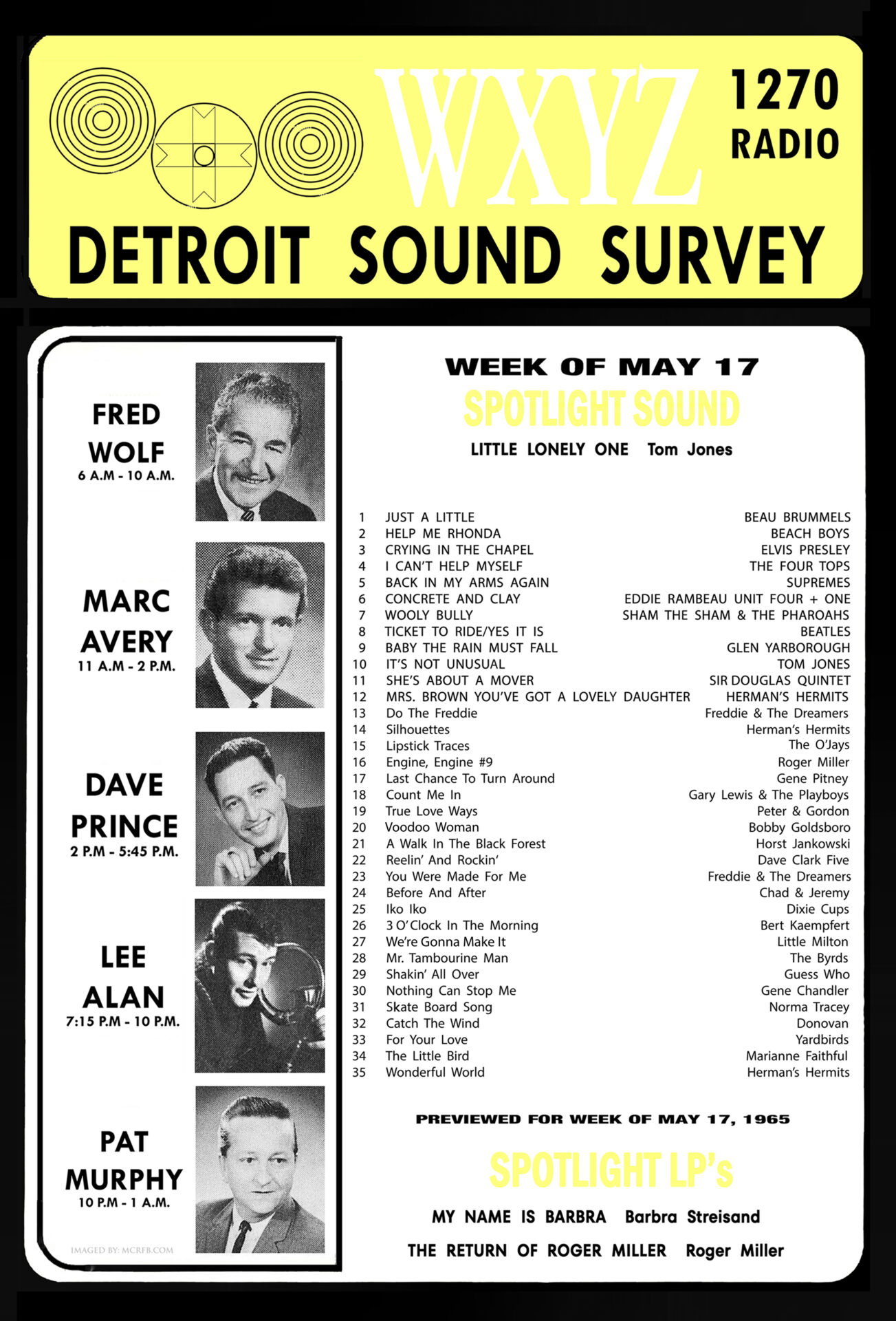
 Newly found! Newly added! Newly restored! From the MCRFB collection. This selected audio recording was digitally remastered for this feature presentation by Motor City Radio Flashbacks.
Newly found! Newly added! Newly restored! From the MCRFB collection. This selected audio recording was digitally remastered for this feature presentation by Motor City Radio Flashbacks.
![]()

![]()
![]()
 ______________________________
______________________________
This list is selected each week by WXYZ Radio reports of records sales gathered from leading record outlets in the Detroit area and other sources available to WXYZ.
The above WXYZ 06/07/1965 chart survey was digitally restored completely in its entirety by Motor City Radio Flashbacks.
![]()
 By mid-January 1965, the Detroit Sound Survey charts was no longer printed for the public in general. The WXYZ charts, as featured above, were instead published solely for Detroit record retailers, music outlets, one-stop jobbers, and distributors only.
By mid-January 1965, the Detroit Sound Survey charts was no longer printed for the public in general. The WXYZ charts, as featured above, were instead published solely for Detroit record retailers, music outlets, one-stop jobbers, and distributors only.
These Radio 1270 top 40 charts was the largest of the WXYZ Detroit Sound Survey charts ever printed, having measured 17.5″ W x 22 L” inches in size. These charts were primarily used for weekly record rank based by popularity, position, retail sales, and were used for record retail rack displays as well.
For the very first time, Motor City Radio Flashbacks will be featuring a dozen or so — as chart dated — of these extremely rare WXYZ 1965 surveys throughout the year, 2024.
![]()
![]() ON YOUR PC? Click on chart image 2x for largest detailed print view.
ON YOUR PC? Click on chart image 2x for largest detailed print view.
ON YOUR MOBILE DEVICE? Tap over WXYZ chart image. Open to second window. “Stretch” chart across your device screen to magnify for largest detailed view.
![]()
![]()
![]()
![]() Normandy landings were the landing operations on Tuesday, 6 June 1944 of the Allied invasion of Normandy in Operation Overlord during World War II. Code named Operation Neptune and often referred to as D-Day, it was the largest seaborne invasion in history. The operation began the liberation of German-occupied France (and later Europe) from Nazi control, and laid the foundations of the Allied victory on the Western Front.
Normandy landings were the landing operations on Tuesday, 6 June 1944 of the Allied invasion of Normandy in Operation Overlord during World War II. Code named Operation Neptune and often referred to as D-Day, it was the largest seaborne invasion in history. The operation began the liberation of German-occupied France (and later Europe) from Nazi control, and laid the foundations of the Allied victory on the Western Front.
![]() Planning for the operation began in 1943. In the months leading up to the invasion, the Allies conducted a substantial military deception, code named Operation Bodyguard, to mislead the Germans as to the date and location of the main Allied landings. The weather on D-Day was far from ideal and the operation had to be delayed 24 hours; a further postponement would have meant a delay of at least two weeks as the invasion planners had requirements for the phase of the moon, the tides, and the time of day that meant only a few days each month were deemed suitable. Adolf Hitler placed German Field Marshal Erwin Rommel in command of German forces and of developing fortifications along the Atlantic Wall in anticipation of an Allied invasion.
Planning for the operation began in 1943. In the months leading up to the invasion, the Allies conducted a substantial military deception, code named Operation Bodyguard, to mislead the Germans as to the date and location of the main Allied landings. The weather on D-Day was far from ideal and the operation had to be delayed 24 hours; a further postponement would have meant a delay of at least two weeks as the invasion planners had requirements for the phase of the moon, the tides, and the time of day that meant only a few days each month were deemed suitable. Adolf Hitler placed German Field Marshal Erwin Rommel in command of German forces and of developing fortifications along the Atlantic Wall in anticipation of an Allied invasion.
![]() The amphibious landings were preceded by extensive aerial and naval bombardment and an airborne assault—the landing of 24,000 US, British, and Canadian airborne troops shortly after midnight. Allied infantry and armoured divisions began landing on the coast of France at 06:30. The target 50-mile (80 km) stretch of the Normandy coast was divided into five sectors: Utah, Omaha, Gold, Juno, and Sword. Strong winds blew the landing craft east of their intended positions, particularly at Utah and Omaha. The men landed under heavy fire from gun emplacements overlooking the beaches, and the shore was mined and covered with obstacles such as wooden stakes, metal tripods, and barbed wire, making the work of the beach-clearing teams difficult and dangerous. Casualties were heaviest at Omaha, with its high cliffs. At Gold, Juno, and Sword, several fortified towns were cleared in house-to-house fighting, and two major gun emplacements at Gold were disabled, using specialized tanks.
The amphibious landings were preceded by extensive aerial and naval bombardment and an airborne assault—the landing of 24,000 US, British, and Canadian airborne troops shortly after midnight. Allied infantry and armoured divisions began landing on the coast of France at 06:30. The target 50-mile (80 km) stretch of the Normandy coast was divided into five sectors: Utah, Omaha, Gold, Juno, and Sword. Strong winds blew the landing craft east of their intended positions, particularly at Utah and Omaha. The men landed under heavy fire from gun emplacements overlooking the beaches, and the shore was mined and covered with obstacles such as wooden stakes, metal tripods, and barbed wire, making the work of the beach-clearing teams difficult and dangerous. Casualties were heaviest at Omaha, with its high cliffs. At Gold, Juno, and Sword, several fortified towns were cleared in house-to-house fighting, and two major gun emplacements at Gold were disabled, using specialized tanks.
![]() The Allies failed to achieve any of their goals on the first day. Carentan, St. Lô, and Bayeux remained in German hands, and Caen, a major objective, was not captured until 21 July. Only two of the beaches (Juno and Gold) were linked on the first day, and all five beachheads were not connected until 12 June; however, the operation gained a foothold which the Allies gradually expanded over the coming months. German casualties on D-Day have been estimated at 4,000 to 9,000 men. Allied casualties were at least 10,000, with 4,414 confirmed dead.
The Allies failed to achieve any of their goals on the first day. Carentan, St. Lô, and Bayeux remained in German hands, and Caen, a major objective, was not captured until 21 July. Only two of the beaches (Juno and Gold) were linked on the first day, and all five beachheads were not connected until 12 June; however, the operation gained a foothold which the Allies gradually expanded over the coming months. German casualties on D-Day have been estimated at 4,000 to 9,000 men. Allied casualties were at least 10,000, with 4,414 confirmed dead.
![]() The Allies planned to launch the invasion on 1 May 1944. The initial draft of the plan was accepted at the Quebec Conference in August 1943. General Dwight D. Eisenhower was appointed commander of Supreme Headquarters Allied Expeditionary Force (SHAEF). General Bernard Montgomery was named as commander of the 21st Army Group, which comprised all land forces involved in the invasion. On 31 December 1943 Eisenhower and Montgomery first saw the plan, which proposed amphibious landings by three divisions with two more divisions in support. The two generals immediately insisted that the scale of the initial invasion be expanded to five divisions, with airborne descents by three additional divisions, to allow operations on a wider front and to speed the capture of Cherbourg. The need to acquire or produce extra landing craft for the expanded operation meant that the invasion had to be delayed to June. Eventually, thirty-nine Allied divisions would be committed to the Battle of Normandy: twenty-two US, twelve British, three Canadian, one Polish, and one French, totalling over a million troops all under overall British command.
The Allies planned to launch the invasion on 1 May 1944. The initial draft of the plan was accepted at the Quebec Conference in August 1943. General Dwight D. Eisenhower was appointed commander of Supreme Headquarters Allied Expeditionary Force (SHAEF). General Bernard Montgomery was named as commander of the 21st Army Group, which comprised all land forces involved in the invasion. On 31 December 1943 Eisenhower and Montgomery first saw the plan, which proposed amphibious landings by three divisions with two more divisions in support. The two generals immediately insisted that the scale of the initial invasion be expanded to five divisions, with airborne descents by three additional divisions, to allow operations on a wider front and to speed the capture of Cherbourg. The need to acquire or produce extra landing craft for the expanded operation meant that the invasion had to be delayed to June. Eventually, thirty-nine Allied divisions would be committed to the Battle of Normandy: twenty-two US, twelve British, three Canadian, one Polish, and one French, totalling over a million troops all under overall British command.
![]() The Normandy landings were the largest seaborne invasion in history, with nearly 5,000 landing and assault craft, 289 escort vessels, and 277 minesweepers participating. Nearly 160,000 troops crossed the English Channel on D-Day, with 875,000 men disembarking by the end of June. Allied casualties on the first day were at least 10,000, with 4,414 confirmed dead. The Germans lost 1,000 men. The Allied invasion plans had called for the capture of Carentan, St. Lô, Caen, and Bayeux on the first day, with all the beaches (other than Utah) linked with a front line 10 to 16 kilometres (6 to 10 mi) from the beaches; none of these objectives were achieved. The five beachheads were not connected until 12 June, by which time the Allies held a front around 97 kilometres (60 mi) long and 24 kilometres (15 mi) deep. Caen, a major objective, was still in German hands at the end of D-Day and would not be completely captured until 21 July. The Germans had ordered French civilians other than those deemed essential to the war effort to leave potential combat zones in Normandy. Civilian casualties on D-Day and D+1 are estimated at 3,000 people.
The Normandy landings were the largest seaborne invasion in history, with nearly 5,000 landing and assault craft, 289 escort vessels, and 277 minesweepers participating. Nearly 160,000 troops crossed the English Channel on D-Day, with 875,000 men disembarking by the end of June. Allied casualties on the first day were at least 10,000, with 4,414 confirmed dead. The Germans lost 1,000 men. The Allied invasion plans had called for the capture of Carentan, St. Lô, Caen, and Bayeux on the first day, with all the beaches (other than Utah) linked with a front line 10 to 16 kilometres (6 to 10 mi) from the beaches; none of these objectives were achieved. The five beachheads were not connected until 12 June, by which time the Allies held a front around 97 kilometres (60 mi) long and 24 kilometres (15 mi) deep. Caen, a major objective, was still in German hands at the end of D-Day and would not be completely captured until 21 July. The Germans had ordered French civilians other than those deemed essential to the war effort to leave potential combat zones in Normandy. Civilian casualties on D-Day and D+1 are estimated at 3,000 people.
Source, information and credit: D-Day Wikipedia
In the early morning hours of June 6, 1944, the CBS and NBC radio networks, centered in New York, took control of the day’s wartime news on all of their respective affiliated stations nationwide — special bulletins and all-day broadcasting of the reported allied invasion off the northern coast of France.
In 1944 the CBS Detroit affiliate was WWJ. The NBC Detroit (Blue Network) affiliate was WXYZ. These historic CBS (WWJ 950) and NBC (WXYZ 1270) broadcasts was heard in wartime Detroit over the radio, on this day, 80 years ago.
Audio portions for this presentation was selected from 24 continuous hours of these broadcasts (24 hours per network) we have in our archives. Today, Motor City Radio Flashbacks highlights the first three hours of the D-Day radio broadcasts as it was reported, respectively, on CBS and NBC radio, in the early-hours of Tuesday morning, June 6, 1944.
![]()
 On your mobile device? Tap over newspaper image. Open to second window. “Stretch” image across your device screen for digitized view.
On your mobile device? Tap over newspaper image. Open to second window. “Stretch” image across your device screen for digitized view.
On your PC? Click on the newspaper image 2x for detailed print view.
![]()

![]()
![]()
 ______________________________
______________________________
This list is selected each week by WXYZ Radio reports of records sales gathered from leading record outlets in the Detroit area and other sources available to WXYZ.
The above WXYZ 06/01/1965 chart survey was digitally restored completely in its entirety by Motor City Radio Flashbacks.
![]()
 By mid-January 1965, the Detroit Sound Survey charts was no longer printed for the public in general. The WXYZ charts, as featured above, were instead published solely for Detroit record retailers, music outlets, one-stop jobbers, and distributors only.
By mid-January 1965, the Detroit Sound Survey charts was no longer printed for the public in general. The WXYZ charts, as featured above, were instead published solely for Detroit record retailers, music outlets, one-stop jobbers, and distributors only.
These Radio 1270 top 40 charts was the largest of the WXYZ Detroit Sound Survey charts ever printed, having measured 17.5″ W x 22 L” inches in size. These charts were primarily used for weekly record rank based by popularity, position, retail sales, and were used for record retail rack displays as well.
For the very first time, Motor City Radio Flashbacks will be featuring a dozen or so — as chart dated — of these extremely rare WXYZ 1965 surveys throughout the year, 2024.

![]()
![]() ON YOUR PC? Click on chart image 2x for largest detailed print view.
ON YOUR PC? Click on chart image 2x for largest detailed print view.
ON YOUR MOBILE DEVICE? Tap over WXYZ chart image. Open to second window. “Stretch” chart across your device screen to magnify for largest detailed view.
![]()
![]()
![]()

![]()
![]()
 ______________________________
______________________________
This list is selected each week by WXYZ Radio reports of records sales gathered from leading record outlets in the Detroit area and other sources available to WXYZ.
The above WXYZ 05/24/1965 chart survey was digitally restored completely in its entirety by Motor City Radio Flashbacks.
![]()
 By mid-January 1965, the Detroit Sound Survey charts was no longer printed for the public in general. The WXYZ charts, as featured above, were instead published solely for Detroit record retailers, music outlets, one-stop jobbers, and distributors only.
By mid-January 1965, the Detroit Sound Survey charts was no longer printed for the public in general. The WXYZ charts, as featured above, were instead published solely for Detroit record retailers, music outlets, one-stop jobbers, and distributors only.
These Radio 1270 top 40 charts was the largest of the WXYZ Detroit Sound Survey charts ever printed, having measured 17.5″ W x 22 L” inches in size. These charts were primarily used for weekly record rank based by popularity, position, retail sales, and were used for record retail rack displays as well.
For the very first time, Motor City Radio Flashbacks will be featuring a dozen or so — as chart dated — of these extremely rare WXYZ 1965 surveys throughout the year, 2024.

![]()
![]() ON YOUR PC? Click on chart image 2x for largest detailed print view.
ON YOUR PC? Click on chart image 2x for largest detailed print view.
ON YOUR MOBILE DEVICE? Tap over WXYZ chart image. Open to second window. “Stretch” chart across your device screen to magnify for largest detailed view.
![]()
![]()
![]()

![]()
![]()
 ______________________________
______________________________
This list is selected each week by WXYZ Radio reports of records sales gathered from leading record outlets in the Detroit area and other sources available to WXYZ.
The above WXYZ 05/17/1965 chart survey was digitally restored complete in its entirety by Motor City Radio Flashbacks.
![]()
 By mid-January 1965, the Detroit Sound Survey charts was no longer printed for the public in general. The WXYZ charts, as featured above, were instead published solely for Detroit record retailers, music outlets, one-stop jobbers, and distributors only.
By mid-January 1965, the Detroit Sound Survey charts was no longer printed for the public in general. The WXYZ charts, as featured above, were instead published solely for Detroit record retailers, music outlets, one-stop jobbers, and distributors only.
These Radio 1270 top 40 charts was the largest of the WXYZ Detroit Sound Survey charts ever printed, having measured 17.5″ W x 22 L” inches in size. These charts were primarily used for weekly record rank based by popularity, position, retail sales, and were used for record retail rack displays as well.
For the very first time, Motor City Radio Flashbacks will be featuring a dozen or so — as chart dated — of these extremely rare WXYZ 1965 surveys throughout the year, 2024.
ON YOUR PC? Click on chart image 2x for largest detailed print view.
ON YOUR MOBILE DEVICE? Tap over WXYZ chart image. Open to second window. “Stretch” chart across your device screen to magnify for largest detailed view.
![]()
![]()
![]()
 This article/advertisement courtesy freep.com newspaper archive. Copyright 2024. Newspapers.com
This article/advertisement courtesy freep.com newspaper archive. Copyright 2024. Newspapers.com
Originally printed in black and white, the featured Detroit Free Press ad was digitally re-imaged, colorized, and was entirely restored by Motor City Radio Flashbacks.
Missed any of our previous ‘Detroit Radio Back-Pages‘ features? GO HERE
_______________

![]()
 MCRFB Note: Special THANKS to our friend, John Bartony (a.k.a. Jukebox John) St. Clair Shores, Michigan, for providing the above Detroit Free Press WXYZ 1270 ad (Sunday, October 2, 1955) for this site, as featured today.
MCRFB Note: Special THANKS to our friend, John Bartony (a.k.a. Jukebox John) St. Clair Shores, Michigan, for providing the above Detroit Free Press WXYZ 1270 ad (Sunday, October 2, 1955) for this site, as featured today.
 A special thank you to senior MCRFB consultant Greg Innis, of Livonia, MI., for contributing the Newspapers.com archives (Detroit radio related) articles, ads, and images we have provide for this site since 2016.
A special thank you to senior MCRFB consultant Greg Innis, of Livonia, MI., for contributing the Newspapers.com archives (Detroit radio related) articles, ads, and images we have provide for this site since 2016.
Thank you, Greg Innis, for making these historic Detroit radio features possible. 🙂

![]()
 ON YOUR PC? You can read this entire newsprint article/ad — the fine print — ENLARGED. For a larger detailed view click above image 2x and open to second window. Click image anytime to return to NORMAL image size.
ON YOUR PC? You can read this entire newsprint article/ad — the fine print — ENLARGED. For a larger detailed view click above image 2x and open to second window. Click image anytime to return to NORMAL image size.
Click your server’s back button to return to MCRFB.COM home page.
ON YOUR MOBILE DEVICE? Tap on newsprint image. Open to second window. “Stretch” image across your device screen to magnify for largest print view.

![]()
This list is selected each week by WXYZ Radio reports of records sales gathered from leading record outlets in the Detroit area and other sources available to WXYZ.
The above WXYZ 05/03/1965 chart survey was digitally restored completely in its entirety by Motor City Radio Flashbacks.
![]()
 By mid-January 1965, the Detroit Sound Survey charts was no longer printed for the public in general. The WXYZ charts, as featured above, were instead published solely for Detroit record retailers, music outlets, one-stop jobbers, and distributors only.
By mid-January 1965, the Detroit Sound Survey charts was no longer printed for the public in general. The WXYZ charts, as featured above, were instead published solely for Detroit record retailers, music outlets, one-stop jobbers, and distributors only.
These Radio 1270 top 40 charts were the largest of the WXYZ Detroit Sound Survey charts ever printed, having measured 17.5″ W x 22 L” inches in size. These charts were primarily used for weekly record rank based on popularity, position, retail sales, and were used for record retail rack displays as well.
For the very first time, Motor City Radio Flashbacks will be featuring a dozen or so — as chart dated — of these extremely rare WXYZ 1965 surveys throughout the year.

![]()
![]() ON YOUR MOBILE DEVICE? Tap over WXYZ chart image. Open to second window. “Stretch” chart across your device screen to magnify for largest detailed view.
ON YOUR MOBILE DEVICE? Tap over WXYZ chart image. Open to second window. “Stretch” chart across your device screen to magnify for largest detailed view.
ON YOUR PC? Click on chart image 2x for largest detailed print view.
![]()
This list is selected each week by WXYZ Radio reports of records sales gathered from leading record outlets in the Detroit area and other sources available to WXYZ.
The above WXYZ 04/26/1965 chart survey was digitally restored completely in its entirety by Motor City Radio Flashbacks.
![]()
 By mid-January 1965, the Detroit Sound Survey charts was no longer printed for the public in general. The WXYZ charts, as featured above, were instead published solely for Detroit record retailers, music outlets, one-stop jobbers, and distributors only.
By mid-January 1965, the Detroit Sound Survey charts was no longer printed for the public in general. The WXYZ charts, as featured above, were instead published solely for Detroit record retailers, music outlets, one-stop jobbers, and distributors only.
These Radio 1270 top 40 charts was the largest of the WXYZ Detroit Sound Survey charts ever printed, having measured 17.5″ W x 22 L” inches in size. These charts were primarily used for weekly record rank based by popularity, position, retail sales, and were used for record retail rack displays as well.
For the very first time, Motor City Radio Flashbacks will be featuring a dozen or so — as chart dated — of these extremely rare WXYZ 1965 surveys throughout the year.

![]()
![]() ON YOUR MOBILE DEVICE? Tap over WXYZ chart image. Open to second window. “Stretch” chart across your device screen to magnify for largest detailed view.
ON YOUR MOBILE DEVICE? Tap over WXYZ chart image. Open to second window. “Stretch” chart across your device screen to magnify for largest detailed view.
ON YOUR PC? Click on chart image 2x for largest detailed print view.
![]()
Lee Alan, a native of Detroit, was born in 1934 and grew up in the city. His passion for broadcasting sparked at the age of 14 while he was an avid fan of WXYZ’s serial, “The Lone Ranger.” After graduating from Cooley High School, he pursued his interest in broadcasting by enrolling at Wayne State University.
His journey in radio began at WCAR, located in Pontiac, followed by a stint at WJLB. Despite a brief period of service in the Army, Alan returned to WJLB for a short time, handling the overnight shift. In 1959, he secured the all-night slot at WJBK, occasionally filling in elsewhere. However, in December of that year, he parted ways with WJBK due to what management described as “simple economics.”
Alan then joined WKMH, where he hosted two shows. In 1962, he departed Detroit for Cincinnati. Shortly after arriving there, Alan received an unexpected call from WXYZ, offering him a new broadcasting opportunity back in Detroit. At one point, he juggled roles in both television and radio, serving as the host of “Club 1270” in 1963 and later transitioning to “The Swingin’ Kind” in 1966, both on WXYZ-TV. Lee Alan concluded his radio career and retired in 1970. For decades thereafter, after opening his own ad agency, his voice was heard on countless car dealership commercials on radio and television in Detroit and around the country.
Today we are presenting Lee Alan’s WXYZ show-opening theme. From 1958 – ZING! WENT THE STRINGS OF MY HEART – by Les Elgart & Orchestra. One of the best remembered, if not the best, themes heard on Detroit radio in the past 60 years.
_______________

![]()
![]() Audio digitally remastered by Motor City Radio Flashbacks
Audio digitally remastered by Motor City Radio Flashbacks
![]()